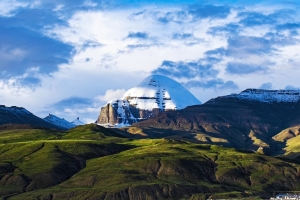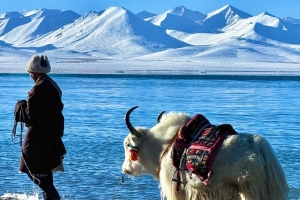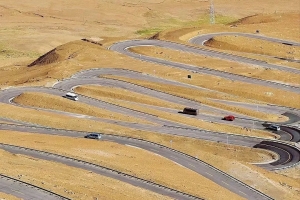Visiting Mount Kailash and Lake Mansarovar is one of the world’s most powerful spiritual journeys and an epic high-altitude adventure. For international travelers starting in Delhi, there are several realistic ways to reach this sacred heart of the Tibetan Plateau: fly-and-drive via Nepal (the most popular and flexible option), overland via the Nepal-Tibet border crossings, or (for Indian nationals) take specially organized pilgrimage routes via Indian border passes such as Lipulekh or Nathu La. This guide explains each practical route, visa and permit requirements, timing and acclimatization advice, rough cost expectations, and travel tips so you can plan confidently and safely.
Why Kailash Mansarovar Matters
Mount Kailash (Kangrinboqê) and Lake Mansarovar are more than dramatic landscapes: they are living religious icons. Hindus revere Kailash as Lord Shiva’s abode; Buddhists identify it with Mount Meru and sacred practice; followers of Bon and Jain traditions also count Kailash among their holiest places. Bathing in Mansarovar, circumambulating (kora) Mount Kailash, and completing the 52-kilometer parikrama are acts of devotion and deep personal transformation for many pilgrims. Beyond the spiritual draw, the raw high-altitude scenery—turquoise lakes, endless plateau vistas, and snow-capped peaks—makes this a once-in-a-lifetime travel experience.
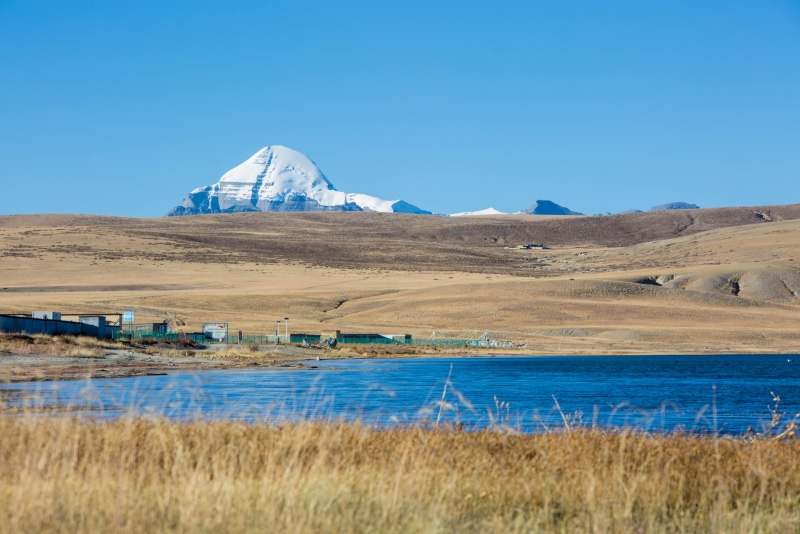
How to Get There: Main Route Options from Delhi
There are three broad approaches for travelers departing Delhi:
- Fly to Kathmandu, then fly or overland to Lhasa and onward to Ngari (Gunsha) / Burang and Kailash — quickest and recommended for most international travelers.
- Overland via Nepal (Kathmandu → Gyirong → Ngari) by road — scenic, good for those who prefer gradual acclimatization and dramatic Himalayan drives.
- Overland from India (for Indian pilgrims only) via Lipulekh or Nathu La — organized pilgrimage routes under Indian authorities and special pilgrimage agencies.
Each path has tradeoffs around travel time, altitude gain, paperwork, cost, and spiritual/ritual requirements. Below we break them down step-by-step.
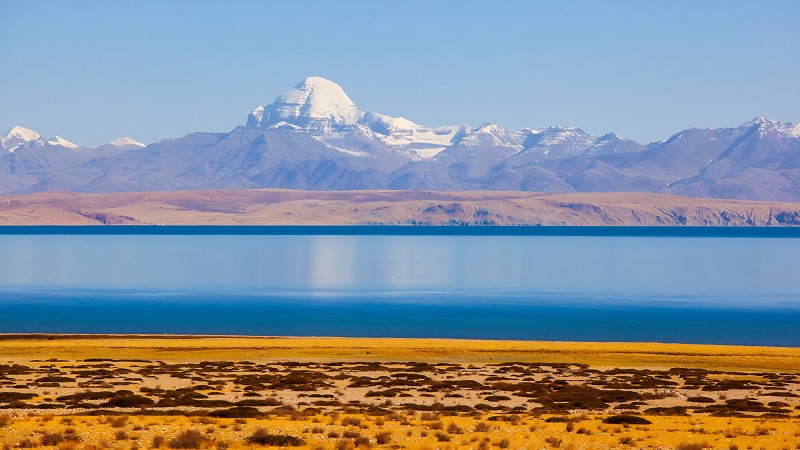
Fly via Kathmandu then Lhasa (Fastest International Option)
Flight Outline and Logistics
Most international travelers bound for Kailash from Delhi choose to fly Delhi → Kathmandu, then Kathmandu → Lhasa (Gonggar), and continue by road to Ngari / Mount Kailash. Flights Delhi → Kathmandu are frequent and short (about 1.5 hours). From Kathmandu to Lhasa, non-stop services operate several times per week and typically take about 1 hour 20–90 minutes; schedules were expanded in recent years and are the primary air link for foreign visitors entering Tibet from Nepal.
From Lhasa to Ngari / Gunsha
After arriving in Lhasa (3,650 m / 11,975 ft), most travelers join an overland tour that gradually gains altitude and travels westward toward Ngari (Ali) and Mount Kailash. Some travelers may choose an internal flight Lhasa → Ngari (Gunsha) to save time, but abrupt altitude jumps increase the risk of altitude sickness—so many guides advise overland acclimatization across 7–15 days instead. Ground transfers from Lhasa to Kailash are typically part of a 12–15 day itinerary that includes key Tibetan sites en route and deliberate acclimatization stops.
Practical tip: Book international flights to Kathmandu first, secure your China group visa or Chinese visa procedures in Kathmandu, and then lock in the Tibet travel permit and tour dates (see permit section below). Flight schedules and availability can change—check current Kathmandu→Lhasa timetables before booking.
Overland via Nepal: Kathmandu → Gyirong → Kailash (Scenic, Gradual Acclimatization)
Why choose overland via Gyirong?
Overland crossings from Nepal into Tibet have become the dominant land route for foreign tour groups because they connect Kathmandu’s services with Tibetan road networks. Gyirong (also spelled Kyirong) is the primary operational border crossing used by international tour groups between Nepal and Tibet; road conditions and traffic windows can be regulated seasonally, so schedules may be limited depending on repairs or local controls. Expect border formalities and sometimes limited daily crossing times.
Typical itinerary sketch
- Delhi → Kathmandu (fly or overnight bus).
- Stay in Kathmandu 2–3 nights while the Tibet tour operator finalizes permits and the Chinese Embassy group-visa process (if relevant).
- Drive or fly to the Nepal border crossing (Gyirong) and complete immigration/permit handovers.
- Enter Tibet and join your guided convoy heading west toward Ngari and Mount Kailash, with multiple days on the road for acclimatization.
What to expect on the road
Long driving days across rugged Himalayan highways are balanced by spectacular views—terraced valleys, remote Tibetan towns, and high passes. Road quality varies; landslides or monsoon damage occasionally slow progress, so flexibility is essential. If you prefer to minimize sudden elevation changes, an overland transit from Kathmandu into Tibet is often ideal.
Overland Pilgrimage from India (Lipulekh, Nathu La) — Indian Nationals Only
Indian pilgrimage routes and organization
Indian pilgrims traditionally use three main land routes to Kailash: Lipulekh (Uttarakhand), Nathu La (Sikkim), and via Nepal. After pandemic disruptions and political pause, organized Kailash Mansarovar yatras for Indian citizens resumed in 2025 under government facilitation: groups are selected and processed through established channels, and the journeys are tightly coordinated—often with lottery selection and set batch departures. The pilgrimage is administered through India’s authorities in coordination with Chinese/Tibetan bodies, and travel is conducted by approved operators.
Important restrictions
Indian pilgrims must register and travel under the official pilgrimage programs; privately organized independent travel to Kailash across Indian border passes is not permitted. Logistics, medical checks, and group size control are part of the process—book through authorized channels well in advance if you’re an Indian national intent on attending a government-organized yatra.
Visas & Permits: Exactly What You Need
China visa / China group visa (from Kathmandu) and Invitation Letter
If you enter Tibet from Nepal, you will typically apply for a China group visa at the Chinese Embassy in Kathmandu. A China group visa requires an invitation letter issued by the Tibet Tourism Bureau (TTB) and must be processed through an authorized Tibet travel agency. In practice, your Nepal-based or Tibet travel operator will prepare the required invitation and submit the group application on your behalf. Expect embassy processing timelines and agency-required lead time—plan accordingly.
Tibet Travel Permit
A Tibet Travel Permit (sometimes called a Tibet Entry Permit or Tibet Tourism Bureau permit) is compulsory for travel anywhere in Tibet and is required even if you are only visiting Kailash. Kailash itineraries often require multiple special permits (for Ali/Ngari region and border crossings), and permit issuance timing varies; specialized Kailash tours typically ask for documents several weeks in advance—many operators request you send passport copies 3–4 weeks before departure to process permits. For the Kailash route you should allow more lead time than for a standard Lhasa tour.
For Indian nationals specifically
When Indian nationals plan to visit Kailash, arrangements must be coordinated through either the Tibet Autonomous Region Foreign Affairs Office or the China-India Pilgrims Service Center (CIPSC). These organizations manage special pilgrimage procedures, group approvals, and on-ground services for Indian pilgrims—private operators cannot substitute for these official channels.

Best Time to Go & Weather
- Peak pilgrimage season: Mid-May to September (summer months and warmer plateau weather). Many organized yatras and permit windows operate during this period.
- Shoulder months: Late April and October can be crisp but may have fewer services and more variable mountain weather.
- Avoid winter months (November–March) unless you’re prepared for extreme cold, road closures, and limited support services.
The plateau climate is high altitude and can be brutally sunlit by day and freezing by night. Always layer and plan for sudden weather changes.
Health & Acclimatization: Don’t Rush the Altitude
Mount Kailash and Mansarovar sit at very high elevations (Ngari / Burang area is often above 4,500 m / 14,760 ft). Altitude sickness is the single greatest risk for travelers. Practical precautions:
- Acclimatize gradually. If flying into Lhasa, spend multiple days there before climbing higher; prefer overland travel that gains altitude slowly.
- Hydrate, eat light, and rest. Avoid alcohol and heavy exertion for 48–72 hours after significant altitude gain.
- Carry medications. Discuss acetazolamide (Diamox) with your doctor before travel and bring oxygen canisters if your itinerary includes very high passes.
- Know symptoms of AMS (acute mountain sickness). Early signs: headache, nausea, dizziness, decreased appetite—descend promptly if symptoms worsen.
Guided Kailash-Mansarovar tours typically build acclimatization days into the itinerary to reduce risk.
What to Pack: Essential Checklist
- High-altitude layered clothing (thermal base layers, fleece, insulated jacket)
- Sun protection (strong UV at altitude — sunglasses, sunscreen SPF 50+)
- Sturdy trekking shoes, good socks, gaiters
- Warm hat, gloves, neck gaiter
- Personal medication, first-aid kit, Diamox (if prescribed)
- Water purification tablets or trusted bottled water supply
- Lightweight sleeping liner (some prefer their own liner)
- Cash (local currency) — remote areas may not accept cards
- Portable oxygen canister (optional but reassuring)
- Travel documents: passport, visa, permit printouts, copies
Cost & Booking Practicalities
Costs fluctuate by season, route, group size, and service level. Expect Kailash Mansarovar pilgrimage packages (overland via Nepal or internal Tibet arrangements) to be a significant investment because of required permits, convoy logistics, specialist vehicles, and remote-area support. For Indian government-organized yatras, the pilgrimage cost is often administered and published by relevant ministries or approved operators and may include lottery or selection processes.
Practical tip: Use a reputable, experienced Tibet tour operator (we recommend booking through authorized agencies who handle Tibet permits and local logistics) and confirm the permit timetable, cancellation terms, and refunds in case of sudden route or border changes.
Make It A Sacred, Safe Journey
Reaching Kailash Mansarovar from Delhi is a deeply rewarding undertaking that blends spiritual pilgrimage with serious high-altitude travel planning. For most international tourists, the Delhi → Kathmandu → Lhasa → overland to Ngari / Kailash route offers a good balance of convenience and safety, while overland Nepal crossings via Gyirong offer scenic roads and slower acclimatization. Indian nationals have the parallel option of government-organized pilgrimage routes via Lipulekh or Nathu La under special arrangements. Note that China group visas via Kathmandu and Tibet Travel Permits are required and must be processed through authorized agencies—plan well in advance and travel with experienced guides.
If you’d like, we can tailor a detailed 12–15 day itinerary from Delhi—flight and overland combinations, day-by-day acclimatization schedule, and a cost estimate—specifically for your travel dates and fitness level. Journey2tibet (our recommended partner) specializes in Kailash Mansarovar yatras and will handle permit applications, on-ground logistics, and experienced Tibetan guides so you can focus on the spiritual experience and the landscape. Contact Journey2tibet for a personalized plan and permit assistance to ensure your yatra is safe, lawful, and unforgettable.
Safe travels—may your journey to Kailash be transformative.



